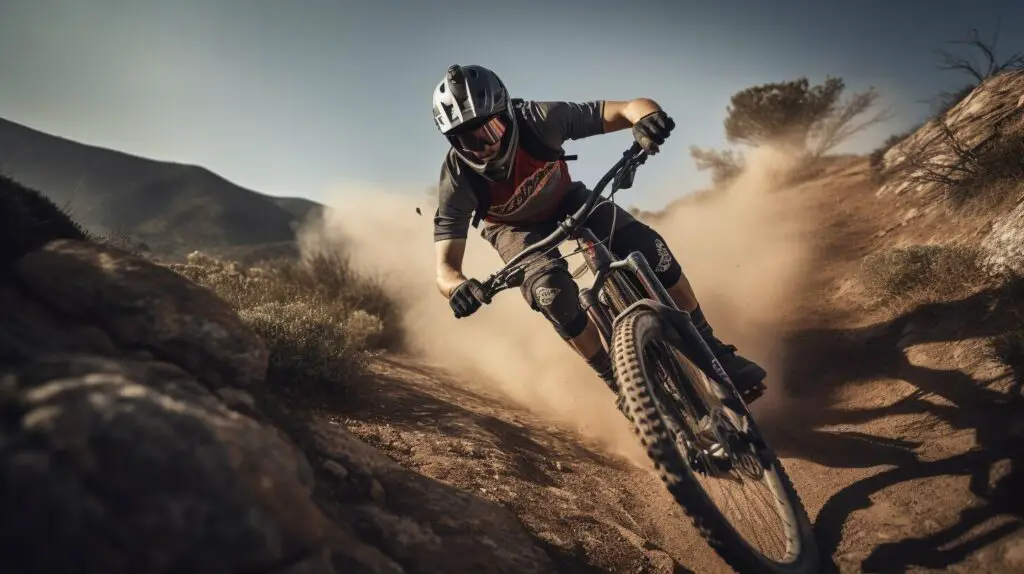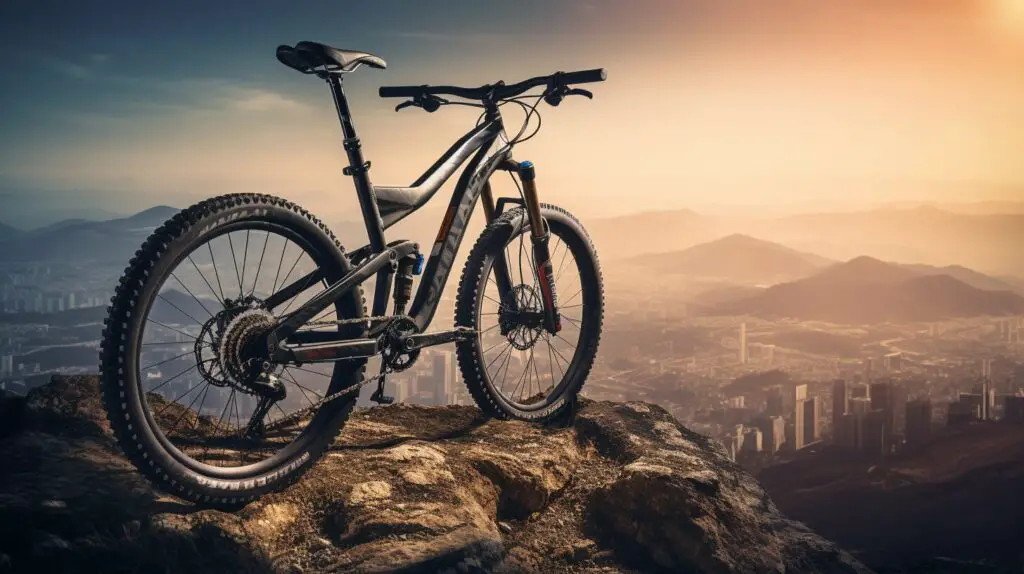Mountain biking can be an exciting and rewarding activity, but it’s important to be aware of the disadvantages that come with it. In this section, we will explore the cons of mountain bikes and help you make an informed decision before investing in one.
Key Takeaways:
- Mountain bikes require regular maintenance to keep them in good working condition.
- They tend to be heavier than other types of bicycles, which can affect speed and agility.
- Mountain bikes may not perform as well on paved surfaces and are less suitable for commuting and road cycling.
- They can be quite expensive compared to other types of bicycles.
- Riding a mountain bike requires a certain level of skill and experience to navigate challenging terrains and obstacles safely.
Advertising links are marked with *. We receive a small commission on sales, nothing changes for you.
Durability and Maintenance Challenges
Mountain bikes are designed to handle rough terrains and demanding conditions, which makes them susceptible to increased wear and tear. Maintenance is crucial if you want to keep your mountain bike in top condition. However, maintaining these bicycles can be challenging and time-consuming.
One of the most notable challenges is the cost of repairs and replacement parts. Mountain bikes have many intricate components, and fixing them can be expensive. Additionally, finding a skilled mechanic who specializes in mountain bikes can be difficult, especially if you live in a rural area.
Another aspect to consider is the durability of the bike itself. While mountain bikes are built to last, prolonged use can lead to damage and breakage. Regular inspections and preventive measures, such as cleaning and lubricating key components, can help extend the lifespan of your mountain bike.

Mountain bikes require more maintenance than other bicycles, and repairs can be costly
Weight and Speed Limitations
One of the biggest drawbacks of mountain bikes is their weight, which tends to be heavier than other types of bicycles. This can make them less efficient for long-distance rides and uphill climbs, where speed and agility are crucial. The added weight can also make it more challenging to transport the bike when not riding.
Another factor that affects speed and efficiency is the suspension system. While it offers benefits on uneven terrain, it can also create drag on smoother surfaces, slowing down the rider. This limitation makes mountain bikes less suitable for road cycling or commuting, where riders need to maintain consistent speeds for longer periods.

Image Source: seowriting.ai
Limited Use on Paved Surfaces
While mountain bikes are designed to handle off-road terrains, they may not perform as well on smooth paved surfaces. The specialized tires and suspension systems that make them suitable for trails and rugged terrain can actually make them less efficient on roads.
This can result in a less comfortable ride and reduced speed and agility, especially when compared to road bikes or hybrid bikes that are designed for more versatile use.
| The downsides to using mountain bikes on paved surfaces include: |
|---|
| Less efficiency: The heavier weight and specialized tread of mountain bike tires can make them less efficient on smooth roads, resulting in slower speeds and more effort required from the rider. |
| Less comfort: The suspension systems that provide a smoother ride on rugged terrain can actually make paved surfaces feel bumpier and less comfortable. |
| Increased wear and tear: Riding a mountain bike on paved surfaces can cause increased wear and tear on the specialized tires, which may result in more frequent replacements and higher costs. |
While it’s possible to use a mountain bike on paved surfaces, it’s important to keep in mind that they are primarily designed for off-road use. If you plan on doing a lot of road cycling or commuting, you may want to consider a more versatile bike that can handle a wider range of terrains and surfaces.

Less Suitable for Commuting and Road Cycling
While mountain bikes are ideal for off-road adventures, they may not be the best option for commuting or road cycling. The design of mountain bikes, with their upright riding position, aggressive tread patterns, and suspension systems optimized for rough terrain, may not provide the same level of comfort and efficiency as road bikes on paved surfaces.
For daily commuting or long-distance road cycling, a road bike may be a better choice due to its lightweight frame, narrow tires, and more aerodynamic riding position. Road bikes are designed for speed and efficiency on smooth roads, which may not be a priority for mountain bikers.
However, if you live in an area where the roads are not well-maintained or if you need to navigate over curbs, potholes, and other obstacles, a mountain bike with its sturdy suspension and thick tires may be a more practical option than a road bike.

Mountain biking can be a thrilling experience, but it may not be the best option for commuting or road cycling.
Higher Initial Cost
One of the main downsides of mountain bikes is their higher initial cost. Compared to other types of bicycles, mountain bikes, especially those with advanced features and technologies, can be quite expensive. The initial investment required to purchase a quality mountain bike may be a deterrent for some riders.
| Factors Affecting Price | Examples |
|---|---|
| Materials Used | Carbon fiber frames, high-end suspension systems, high-performance tires |
| Brand and Reputation | Well-known and established brands with a strong reputation for quality |
| Technological Advances | Bikes with cutting-edge technology, such as electronic shifting or wireless connectivity |
However, it’s important to consider the long-term value of a mountain bike. While the initial cost may be high, a quality mountain bike can provide years of enjoyment and adventure. It’s also important to note that there are mountain bikes available at a lower price point, although they may not have all the advanced features and technologies of more expensive models.

Image source: Pexels
Skill and Experience Requirements
It’s important to note that riding a mountain bike requires a certain level of skill and experience. While it may seem like a fun and easy activity, navigating challenging terrains and obstacles safely can be difficult for beginners.
In fact, without the proper techniques and knowledge, riding a mountain bike can be dangerous and lead to accidents and injuries. It’s crucial for riders to learn and practice the necessary skills before taking on more difficult trails.
Some of the essential skills include proper body positioning, shifting gears, braking, and maneuvering around obstacles. Additionally, riders need to be familiar with the trail and have a good understanding of their bike’s capabilities to avoid accidents and injuries.
Our advice is to start with easier trails and gradually work up to more challenging routes. Seek guidance from experienced riders or consider taking a course to learn the basics. By doing so, you’ll not only improve your riding skills but also minimize the risk of injuries.
“Mountain biking is not only about the adrenaline rush and conquering tough terrains. It’s also about developing the necessary skills and techniques to do it safely and responsibly.”
Conclusion
As we’ve explored in this article, mountain bikes come with a variety of disadvantages and cons that riders should be aware of before investing in one. From the durability and maintenance challenges of navigating rough terrains to the weight and speed limitations that can impact overall performance, there are several factors to consider.
Additionally, mountain bikes may not be the best choice for commuting or road cycling due to their specialized design and limited use on paved surfaces. Furthermore, the initial cost of purchasing a quality mountain bike can be a deterrent for some riders.
It’s essential for riders to have the necessary skill and experience to handle the technical aspects of mountain biking safely. Beginners may find it challenging to navigate challenging terrains and obstacles safely.
Overall, while mountain bikes offer the thrill of off-road adventure, it’s important to weigh the pros and cons before investing in one. We hope this article has provided you with valuable insights into the disadvantages of mountain bikes.
FAQ
Q: What are the disadvantages of mountain bikes?
A: Mountain bikes have several drawbacks and negative aspects. Let’s explore some of the cons that riders may encounter when using these off-road bicycles.
Q: What challenges are there in terms of durability and maintenance?
A: Mountain bikes are subjected to rough terrains and demanding conditions, which can lead to increased wear and tear. Regular maintenance is required to keep them in good working condition and repairs and replacement parts can be costly.
Q: What are the weight and speed limitations of mountain bikes?
A: Mountain bikes tend to be heavier than other types of bicycles, which can make them less efficient for long-distance rides and uphill climbs. The weight can also affect the overall speed and agility of the rider.
Q: Can mountain bikes be used on paved surfaces?
A: Mountain bikes are designed for off-road use and may not perform as well on paved surfaces. The tires and suspension systems are optimized for uneven terrain, which can result in less comfortable rides and reduced efficiency on smooth roads.
Q: Are mountain bikes suitable for commuting and road cycling?
A: Due to their specialized design, mountain bikes may not be the best choice for commuting or road cycling. The upright riding position, aggressive tread patterns, and suspension systems may not offer the same level of comfort and efficiency as road bikes.
Q: What is the initial cost of mountain bikes?
A: Mountain bikes, especially those with advanced features and technologies, can be quite expensive compared to other types of bicycles. The initial investment required to purchase a quality mountain bike may be a deterrent for some riders.
Q: What skill and experience are required for riding mountain bikes?
A: Riding a mountain bike requires a certain level of skill and experience to navigate challenging terrains and obstacles safely. Beginners may find it difficult to handle the technical aspects of mountain biking, which can lead to accidents and injuries.
Conclusion
While mountain bikes offer the thrill of off-road adventures, they also come with several disadvantages. From durability and maintenance challenges to limitations on paved surfaces and higher costs, it’s important for riders to consider these cons before investing in a mountain bike.

Hi dear visitor! I’m Sebastian, a bike maniac who loves to spend a lot of time on two wheels in nature (I love white chocolate, so I absolutely need a calorie-burning balance that’s fun to boot ). Blogging is my second great passion. That’s why cyclinghalloffame.com regularly features new bike-related content.
Advertising links are marked with *. We receive a small commission on sales, nothing changes for you.
